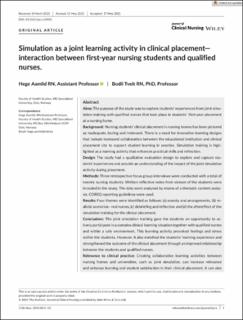| dc.contributor.author | Aamlid, Hege Ingeborg | |
| dc.contributor.author | Tveit, Bodil | |
| dc.date.accessioned | 2021-08-10T12:37:17Z | |
| dc.date.available | 2021-08-10T12:37:17Z | |
| dc.date.created | 2021-06-15T10:49:13Z | |
| dc.date.issued | 2021 | |
| dc.identifier.citation | Journal of Clinical Nursing (JCN). 2021, 1-12. | en_US |
| dc.identifier.issn | 0962-1067 | |
| dc.identifier.uri | https://hdl.handle.net/11250/2767207 | |
| dc.description.abstract | Aims: The purpose of the study was to explore students’ experiences from joint simulation training with qualified nurses that took place in students´ first-year placement at a nursing home.
Background: Nursing students’ clinical placement in nursing homes has been pictured as inadequate, boring and irrelevant. There is a need for innovative learning designs that include increased collaboration between the educational institution and clinical placement site to support student learning in practice. Simulation training is highlighted as a learning activity that enhances practical skills and reflection.
Design: The study had a qualitative evaluation design to explore and capture students’ experiences and provide an understanding of the impact of the joint simulation activity during placement.
Methods: Three retrospective focus group interviews were conducted with a total of twenty nursing students. Written reflective notes from sixteen of the students were included in the study. The data were analysed by means of a thematic content analysis. COREQ reporting guidelines were used.
Results: Four themes were identified as follows: (a) anxiety and arrangements, (b) realistic scenarios—real nurses, (c) debriefing and reflection and (d) the aftereffect of the simulation training for the clinical placement.
Conclusions: The joint simulation training gave the students an opportunity to actively participate in a complex clinical learning situation together with qualified nurses and within a safe environment. This learning activity provoked feelings and stress within the students. However, it also enriched the students’ learning experience and strengthened the outcome of the clinical placement through an improved relationship between the students and qualified nurses.
Relevance to clinical practice: Creating collaborative learning activities between nursing homes and universities, such as joint simulation, can increase relevance and enhance learning and student satisfaction in their clinical placement. It can also promote nursing homes as interesting learning arena and future workplace for nursing students. | en_US |
| dc.language.iso | eng | en_US |
| dc.publisher | Wiley | en_US |
| dc.relation.uri | https://onlinelibrary.wiley.com/doi/10.1111/jocn.15903 | |
| dc.subject | Sykepleierstudenter | en_US |
| dc.subject | Nursing students | en_US |
| dc.subject | Sykehjem | en_US |
| dc.subject | Nursing Homes | en_US |
| dc.subject | Simulering | en_US |
| dc.subject | Simulation | en_US |
| dc.title | Simulation as a joint learning activity in clinical placement - interaction between first-year nursing students and qualified nurses | en_US |
| dc.type | Peer reviewed | en_US |
| dc.type | Journal article | en_US |
| dc.description.version | publishedVersion | en_US |
| dc.rights.holder | Open Access | en_US |
| dc.subject.nsi | VDP::Sykepleievitenskap: 808 | en_US |
| dc.subject.nsi | VDP::Nursing science: 808 | en_US |
| dc.source.pagenumber | 1-12 | en_US |
| dc.source.journal | Journal of Clinical Nursing (JCN) | en_US |
| dc.identifier.doi | 10.1111/jocn.15903 | |
| dc.identifier.cristin | 1915851 | |
| cristin.ispublished | true | |
| cristin.fulltext | original | |
| cristin.qualitycode | 2 | |
